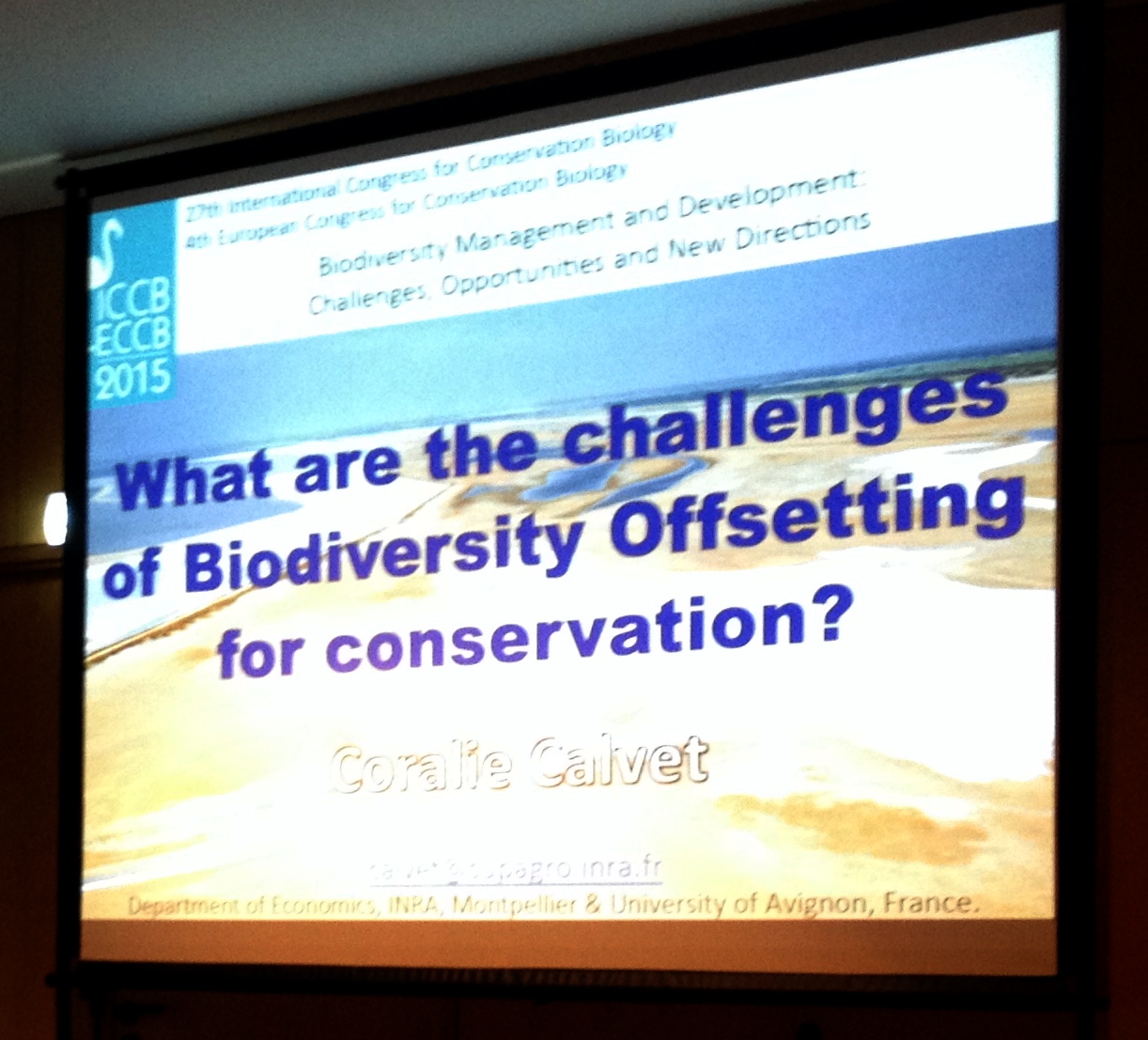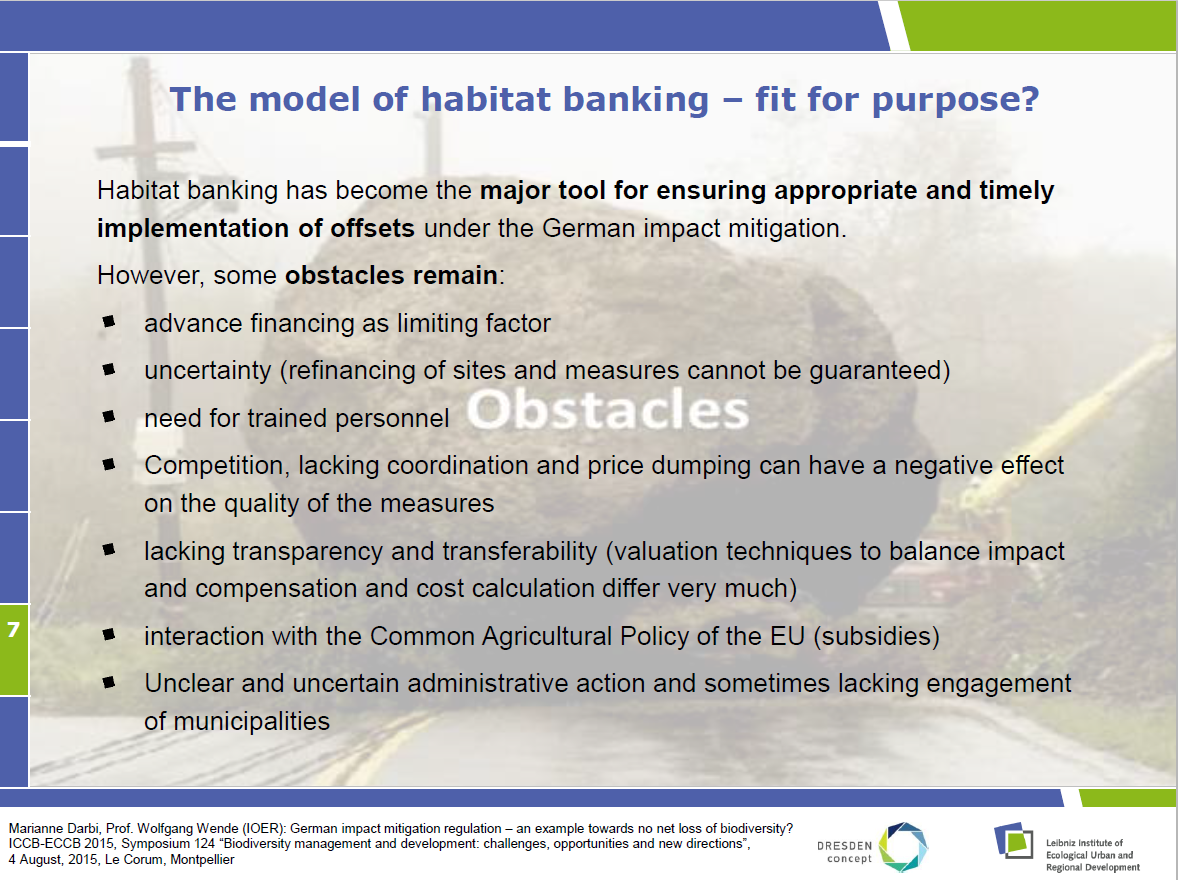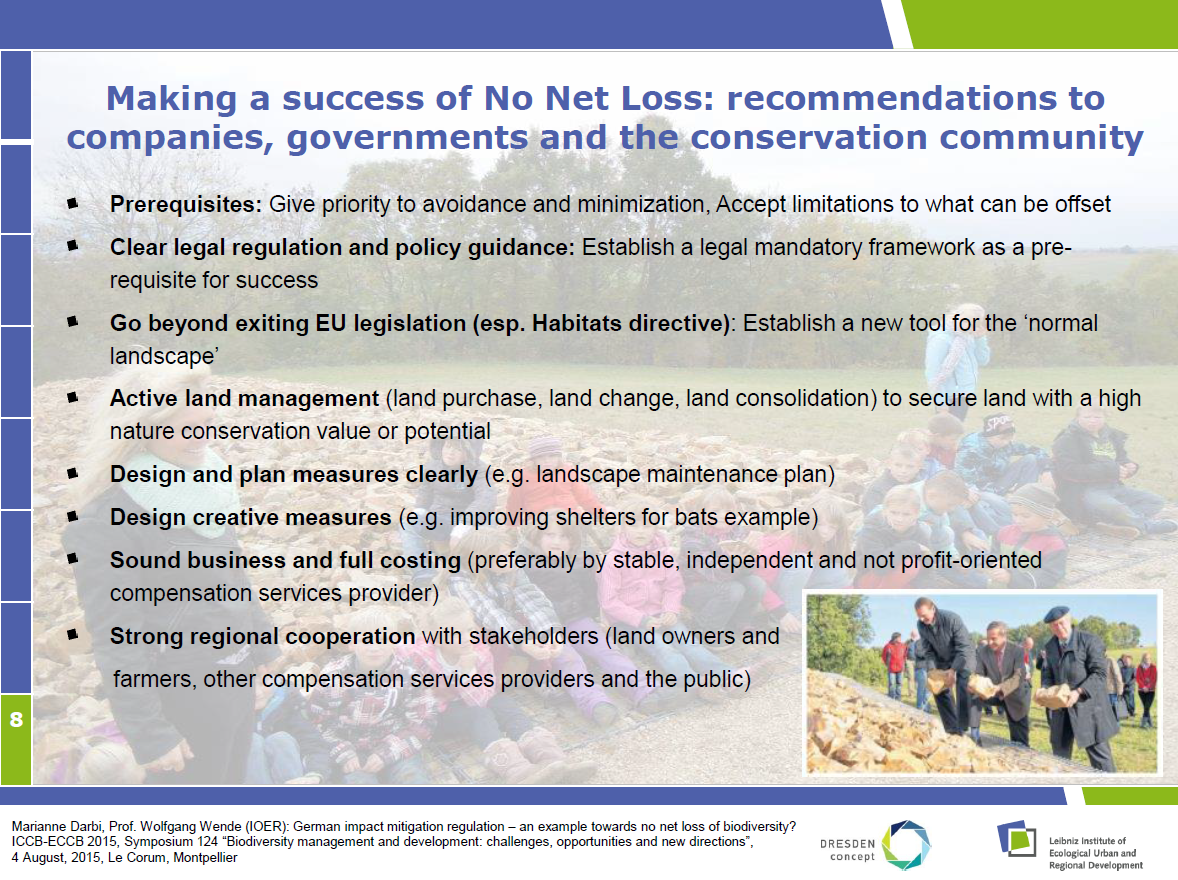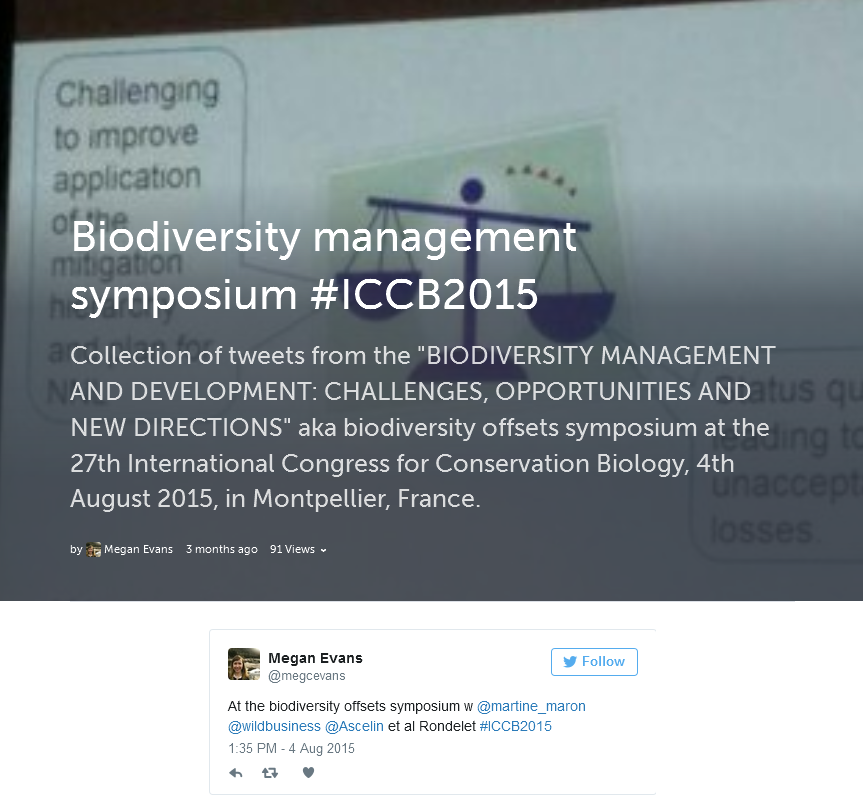 Well, as I have mentioned in my previous post today sometimes it’s the more interesting things that slip through your fingers, even with your best intentions — or because of them. This was particularly the case for the “Biodiversity management and development: challenges, opportunities and new directions” symposium I attended (and contributed to) at ICCB-ECCB. This was a fantastic line-up of experts in the filed of offsets and topical discussion on the subject. I had very briefly posted about this while still at the conference and shared some visual impressions (Biodiversity Offsets are all-around at the 27th International Congress for Conservation Biology ICCB-ECCB 2015) together with the promise to have some more detailed feedback soon after. Because I thought this deserved greater attention I haven’t actually done it so far (which is a pity). Other great people however have pulled something together and I will now at least share their tremendous work in summarizing before everyone ultimately forgets ICCB-ECCB even happened.
Well, as I have mentioned in my previous post today sometimes it’s the more interesting things that slip through your fingers, even with your best intentions — or because of them. This was particularly the case for the “Biodiversity management and development: challenges, opportunities and new directions” symposium I attended (and contributed to) at ICCB-ECCB. This was a fantastic line-up of experts in the filed of offsets and topical discussion on the subject. I had very briefly posted about this while still at the conference and shared some visual impressions (Biodiversity Offsets are all-around at the 27th International Congress for Conservation Biology ICCB-ECCB 2015) together with the promise to have some more detailed feedback soon after. Because I thought this deserved greater attention I haven’t actually done it so far (which is a pity). Other great people however have pulled something together and I will now at least share their tremendous work in summarizing before everyone ultimately forgets ICCB-ECCB even happened.
First of all, there is Megan Evans who was tweeting throughout the symposium and the whole conference (I admire this and still think I need to get on twitter, too some time in the future when time goes less fast, the grass is greener and the sun is shining… ;o)). Out of these tweets and some additional information Megan created a storify that sums it up quite nicely (see below).
Fabien Quétier went even a step ahead and created this concise and still comprehensive summary (see also below).
Before I forget it, I at least want to share my own presentation from the symposium (2015_Darbi_Montpellier_German IMR_extended). I had attempted have all the other’s too, but obviously not everyone was comfortable with that, so anyone who wants to join, leave me a short note and I’d be happy to upload yours, too!
Biodiversity management symposium #ICCB2015 — storify collection of tweets
Here’s the link to Megan’s awesome storify. By the way, she also gave a presentation in a different session dealing with the problem of evaluation of policies and the question whether no net loss is ultimately possible — she has posted about this on her blog where you can also download her presentation: Is no net loss possible? My #iccb2015 presentation.
Symposium on BIODIVERSITY MANAGEMENT AND DEVELOPMENT: CHALLENGES, OPPORTUNITIES AND NEW DIRECTIONS at the 27th International Congress for Conservation Biology, 4th August 2015, in Montpellier, France — a summary by Fabien Quétier
With biodiversity in continued global decline, there is increasing concern that its loss should not be accelerated by the impacts of development projects. Goals of ‘no net loss’ or ‘net gains’ of biodiversity are being set by corporations, banks and governments, including the European Union through its No Net Loss initiative (expected in 2015). Interpreting and tracking these goals, and implementing actions to achieve them, pose challenges that have technical, socio-economic and political dimensions.
Through contributions from key experts from academia, industry, conservation organizations and specialized consultancies, the symposium illustrated the concepts underlying no net loss/net gain approaches (including biodiversity offsets) and the latest developments from science, policy and practice. High quality exchanges with participants focused on the need and opportunity for conservation biologists to engage, so as to shape the debate and contribute to emerging best practice, as well as the limits and risks of poorly designed offsets and policies.
A key message from the symposium is conservation scientists can have a role in clarifying the meaning of ‘no net loss’, which is an incredibly difficult goal to achieve in practice. Although expectations should be modest, conservation biologists need to find pragmatic solutions to biodiversity loss from development. This means keeping eyes on big picture.
Biodiversity offsets can be done really well, but if not, they can become a “license to trash”. Governance, in particular, is crucial: most issues with poor offset implementation is due to inadequate monitoring and evaluation, which also generates low public trust. Conservation science also has a key role to play in evaluating offset policies and practice, and making the results publicly available.
Order of presenters:
- Kerry ten Kate, Forest Trends
- Joseph Bull, University of Copenhagen
- Steven Dickinson, Total
- Leon Bennun, The Biodiversity Consultancy
- Martine Maron, University of Queensland
- Jussi Laitila, University of Helsinki
- Ascelin Gordon, RMIT University
- Marianne Darbi, Leibniz Institute of Ecological Urban and Regional Development (IOER)
- Celine Jacob, Créocéan & CEFE
- Fabien Quétier, Biotope
- Coralie Calvet, INRA
- Joseph Kiesecker, The Nature Conservancy
For more information contact Fabien Quétier fquetier@biotope.fr ; +33 621 51 26 66
Overview of the symposium and key messages
Kerry ten Kate set the scene with a call for action, to find solutions to biodiversity loss from development, arguing that mitigation measures planned for no net loss, including offsets, can be part of the solution when undertaken according to high standards. Conservation biologists need to contribute!
At ICCB 2015, Kerry ten Kate calls to action.
Joe Bull and WCMC had a look at how much offsetting is actually being done… For example, only 0.02% of USA land area are recognized as biodiversity offset sites (“species banks”). This is interesting given the controversy they generate.
Steven Dickinson, from oil major Total, presented the business case for a corporation to be proactive regarding biodiversity: more trust, less delays. As part of their biodiversity strategy TOTAL partners with local NGOs with expertise to implement commitments on the ground. It’s not just about governments regulating the private sector.
Concerning the role of government, Leon Bennun explained how there are many ways of designing policies around ‘no net loss’, which must articulate the ‘no net loss’ objective with e.g. pre-existing policies on land-use or sectorial regulations.
Martine Maron went on to show how policies must be explicit about what they mean by ‘no net loss’ and how they calculate it. Her work in Australia has shown that the baseline against which losses and gains are calculated doesn’t reflect the actual rates of biodiversity loss, leading to a ‘net loss’ outcome.
At ICCB 2015, Martine Maron shows how offset policies in Australia risk ‘locking-in’ biodiversity losses from forest clearing.
Jussi Laitila summed up some of the key risks associated with poorly designed offset policies, and the scientific challenges associated with measuring biodiversity losses and gains, taking into account time lags and actually implementing when those involved have competing interests.
At ICCB 2015, Jussi Laitila presents perverse incentives associated with offsets.
After an active questions & answers session, Ascelin Gordon went on to explain how modelling can be used to conduct ex-ante evaluations of offset policies, in particular regarding the critical issue of counterfactuals.
Marianne Darbi gave us insights on over 30 years of experience with biodiversity offsets in Germany. The country has a mandatory offsets system, which operates at State level, using ‘habitat banking’ as a major tool for implementing offsets in spite of obstacles such as financial uncertainty, lack of capacity, transparency, and clarity with EU directives.
Céline Jacob went on to present lessons learned from the application of the mitigation hierarchy to off-shore and coastal projects in Europe. Incredibly, a large share (42%) of environmental measures tied to such projects are for monitoring… yet we still lack data on outcomes!
At ICCB 2015, Céline Jacob shows us where the money for biodiversity goes in offshore and coastal development projects.
Fabien Quétier presented an extreme case for achieving ‘no net loss’ using the mitigation hierarchy and offsets: the forest landscape that straddles the border between Cameroun, Congo and Gabon, which harbors large road-less areas of lowland rainforest as well as… world class deposits of iron ore. Can the forest be restored?
Speaking of restoration, Coralie Calvet presented the investment by a pilot ‘habitat bank’ in France which restored over 300 ha of dry grasslands in Southern France. The company faced considerable difficulties in making offset trades due to strict equivalence (like-for-like) requirements, and there is a clear incentive to loosen these requirements to favor private investments in conservation and restoration on the basis of offsets.
Joe Kiesecker concluded the symposium by taking a step back and making the case for landscape-level planning, where development and biodiversity objectives can be jointly optimized, including no-go (avoidance) areas. He gave examples from Kansas, as well as South America.
The symposium led to numerous exchanges with the audience, on key concepts – including their ethical and political dimensions – and pragmatic solutions and challenges. A very rich topic indeed!
See also my related post SHORT INFO — Biotope au Congrès Mondial de Biologie de la Conservation



